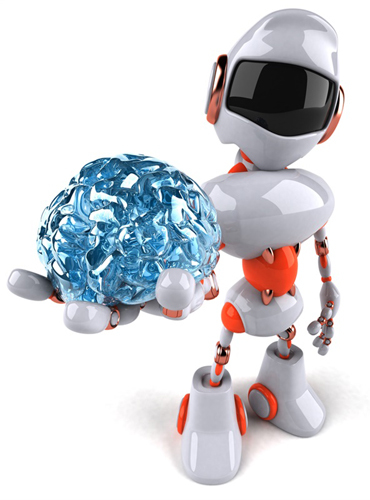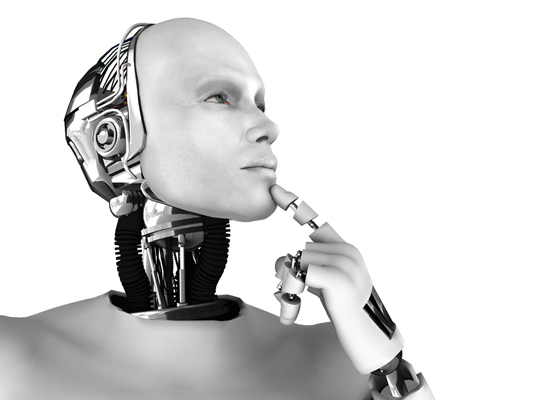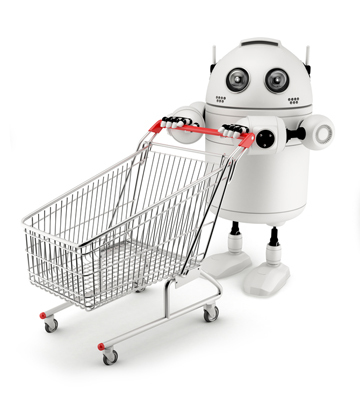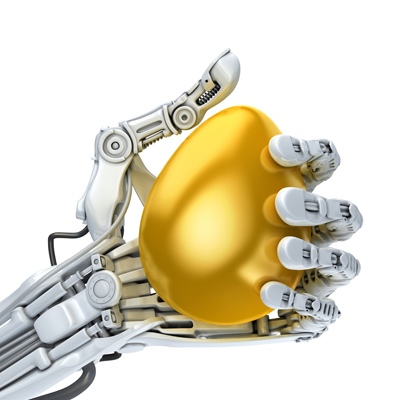Brain, Soul and Mechanical Shell: Mix and Shake
You go to another dimension not only of visions and sounds, but also of the mind. (Twilight Zone)
Right now and at every subsequent minute we live in a certain degree of “predictable” society. The best way to be successful in it is to understand all the limitations, methods, and goals of models that build scientifically based predictions for the future. But the ability to predict the future loses its value in comparison with the ability to create, to become the author of this future. Where, as in robotics and mechanical engineering, can one achieve perfection in this? Of course, in many other related areas. Now we will not break - pay attention only to robotics.
What happens if you teach the robot to find mistakes in itself and correct them?
Scientists often define research goals for themselves. But the real big task is taking control out of the hands of scientists and forcing them to work on much more complex problems than they would set themselves. (IBM Technical Advisor Edward Nazarko)

Someone said that the data is new oil. Using the accumulated information in dozens of areas of activity, you can achieve higher synergy and live in a harmonious community of people, robots and machines, to which we are gradually moving. This is not a pathetic film reality. You yourself know about successful experiments on the transfer of thoughts at a distance between two people through computers.
')
Robotics and mechanical engineering itself is an area that has been around for decades. You can cite as an example even the omnipresent Leonardo da Vinci. There were many attempts, aspirations, and now we need those who will take society to another new level of development, when robots will be available. Already there are robot helpers for life. So far they are too expensive for mass production and consumption.
For example, Honda, iRobot, KUKA Roboter GMBH, ABB, FANUC Robotics are engaged in the production of various robots. In Russia - Rbot, Robotics, RoboCV, Taris. This is not to say that our country is behind the rest in the development of robotics and engineering. Three years later, the World Robotics Championship will be held at the Tomsk State University.
In addition to simply performing the programmed functions, the machines are learnable. An example is the Watson supercomputer that won the Jeopardy game! 4 years ago. Author David Gondek later collected such reviews about his iron brainchild: “Watching Watson famously give an answer for answering a wide variety of questions, including abstract reasoning, metaphors and subtle puns, I was dumbfounded. For the first time in my life, I felt that I was ready to humanize the machine to a large extent, to put aside my usual mistrust and to believe in a miracle. In my opinion, Watson masterfully operates not only with information, but also with knowledge. From the point of view of my perception, he is endowed with a certain ability to think. Honestly, I did not imagine that I would ever experience such a feeling in my life. For me, Watson is the first true artificial intelligence, ”said Eric Siegel, Ph.D., lecturer and educator in predictive analytics.
Let us argue?
A robot cannot harm a person or by its inaction allow a person to be harmed. (the first law of robotics A. Azimov)
The development of the field of robotics and engineering constantly raises the question: is a computer capable of understanding possible? Well, or will the machines be able to replace a person - to win or complement human society today?

Machines that are already in our everyday life, little is understood. It's hard to argue with that. However, researchers argue that after some time, robots running computers with real intelligence will be no more surprising than an electric kettle.
Proponents of the theory of strong artificial intelligence are confident that machines with all of them, for the time being, exclusively human attributes (consciousness, self-consciousness, ability to reflect) are a reality that is already gradually occurring. While not so widely and everywhere, but still. If this theory is confirmed, it will become true for science that understanding (along with all the other human qualities listed above) requires awareness. The first step to understanding any situation is its full awareness. If you calculate data from all sides, you can get the illusion of understanding. However, true understanding allows you to do without masses of calculations. From this it follows that understanding and computation are not interchangeable concepts, but complements to each other.
Roger Penrose, a professor of mathematics at the University of Oxford, speaks against this theory: “Some of my complex arguments are speculative, but I still have a strong feeling that the conscious mind clearly cannot work as a computer.” He believes that non-biological machines cannot overcome the difference between comprehension and computation. Roger argues that in order to clarify understanding you need to go beyond the generally accepted view of the world in which we live. Instead, attention must be paid to physical concepts, which include the quantum world with a largely unknown mathematical structure. Understanding, of course, is connected with the brain. Roger is convinced that a separate component of brain tissue is responsible for the function of understanding.
In the human body there are small structures - microtubules - most of them in the nerve cells. The generation of consciousness is as follows: microtubules from brain cells can reproduce a stable quantum state that binds cell activity. The latter, in turn, are excited throughout the brain. It is considered that the described condition cannot be repeated in the computer. But still it is very interesting to explore this possibility of tiny structures. However, this is a slightly different story. Although on a related topic. And as it has long been clear to the thinking person in the 21st century, highly specialized professions have long become an atavism.
What do you answer the question "can a machine replace a person"?

Professors, associate professors, other practical experts in the field of robotics and mechanical engineering analyzed in a certain sense the future of their field and made a list of the most popular professions in the foreseeable future.
Immediately make a reservation, the profession of the future is not the occupation that will appear after some time. This is a kind of activity that is gradually becoming common, familiar and widespread today. Today we are not surprised by programmers, marketers and other familiar posts. The professions of the future are not fiction at all, but our reality, to which we are constantly involved, if we do not remain mere outside observers.
Intra-industry specializations
- Industrial Robotics Designer
Will be engaged in the preparation of automatic devices for production operations and logistics. Manipulators and robotic complexes as well. - Engineer composer
His responsibilities will include the selection of composite materials in order to further produce elements of robotic devices. 3D printing will be for him the same tool as before the accounts for the accountant. - Home Robots Designer
If you become them, you will develop and program robots for your home (mechanical assistants: nurses, cleaners, laundresses, gardeners ..). We'll have to think about the integration of all these robots into the smart home system. - Robot Neurointerface Designer
This is even more interesting. It will be necessary to design control systems for combat and industrial robots using neural interfaces.
Cross-sectoral specialization
- The operator of multifunctional robotic systems
Working profession: you will need to manage and maintain robotic systems. - Ergonomist Designer
Will receive data on the ergonomic requirements of users and processing them to design “robo-systems”. - Medical Robots Designer
The specialty is on the border of medicine and robotics. Graduates of this particular direction will be able to create biocompatible complexes of robots and equipment for medicine and biotechnology. - Children's Robot Designer
If you like gadgets, games, toys for children - create them on the basis of robots with all kinds of programs.
Read more about the professions in the atlas . The resource can be called the “Cloud Atlas of Professions” - by analogy with the film, all professions are connected by a single chain of rapid development of the present into the future.
Broad abilities and skills of working with people, artistic creativity, managing complex projects, inter-sectoral communication will be useful for all these professions to varying degrees; customer focus, systems thinking, programming ... This is not a complete list. If you have some of the qualities listed, you can easily supplement it with the rest. If not - no problem, there are other areas for studying and self-improvement as an actual specialist now and after 20 years.
An exemplary portrait of the perfect “robotics”

- fluent in at least three foreign languages and knows the characteristics of the cultural context of most countries;
- understands technology, processes and market situation in all related areas;
- works easily with any requests from consumers and manages processes in projects;
- able to work in conditions of high uncertainty and quick change of tasks. Make the right decisions in the shortest possible time, correctly allocate resources and manage their time;
- thinks systematically and within the framework of the environmental friendliness of the entire production, constantly working to eliminate all types of losses.
Where to go to study in Russia
- Moscow State Engineering University (MAMI)
- Moscow Institute of Physics and Technology (MIPT)
- National Research Tomsk State University (TSU)
- National Research Nuclear University "MEPhI"
- National Research Tomsk Polytechnic University (TPU)
- St. Petersburg National Research University of Information Technologies, Mechanics and Optics (NRU ITMO)
- Moscow State Technical University of Radio Engineering, Electronics and Automation (MSTU MIREA) (direction "biotechnical and medical devices and systems")
Special training programs will appear on the basis of these universities, corporate universities, global educational providers: Coursera, EdX.
We pass through time
Do you think that the names of professions sound boring? Maybe you are right. But these are only preliminary predictions. Take, for example, robot control systems. They are biotechnical (exoskeleton), automatic, interactive. The tasks that the control systems solve are also different - the planning of forces and moments, positions, movements, and also the analysis of dynamic accuracy. Here by the way there will be knowledge of the “sciences of the past”: the theory of automatic control and technical cybernetics.
There is room for electrical enthusiasts as well. In order to create mobile and manipulative robots of wide application, we need drives, DC motors, elastic nanotubes.
Future of the future
“The future has one peculiarity: you just have to look at it, how it changes immediately.” (“The Prophet” film)
It is difficult to predict with absolute accuracy the details and timing of the changes that the professions will bring. One thing to say is the development of robotics and engineering, and every minute becomes more intense at least exponentially.
We are confident that the possibilities of this scientific and applied field with new specialists in the leading role will amaze everyone. In any case, what will be the future, time will tell.
Justification vs opportunity
History from the 70s: Yoki Matsuoka and her "human" hand playing tennis
Surprisingly, with the known high speed of development of everything in the world, there are still those who stubbornly argue that the future and technology are purely for men. Also, there are those people who complain about the lack of opportunities and technical base for development ...

There was a girl Yoki. The country is Japan, the time is the 1970s. The rigid education system prescribed, and did not give a choice. Yoki Matsuoka played the piano and practiced professional swimming. It was painful, because in her field of interest was mathematics and science. At the age of 11 she began to play tennis. Later she managed to combine two of her favorite areas - sports and science. At first the tennis robot was a dream. At the Department of California Berkeley Yoki made a graduation project in the laboratory of robotics. Later at MIT (under the direction of the pioneer of robotics Rodney Brooks), the Japanese began to develop the hand and arm of the robot. She found a unique solution that lies in the field of neuro-robotics.
Most of her colleagues reduced the essence of the task to purely technical areas - microchips and devices. For them, the robot was exclusively apparatus. That was a mistake. It was not necessary to see the robot as a mobile computer that can imitate individual models of thinking. In contrast to this approach, Matsuoka focused on combining many areas of knowledge. The approach, in which any small thing is important, justified itself in everything. It was possible to create something as faithful as possible in terms of anatomy. The arm turned out to be as complex and precise in movement as its real physical counterpart.
Moral of the story: if in some country, environment, there are rules and familiar trends - this is no reason to reject the desire to try something of their own and do it in a new way. In Japan, it was hard to break traditions, but Yoki found her mentor Brooks in the USA. Who knows, maybe in the above-mentioned universities of the Russian Federation, a gray-haired innovator is waiting for a capable student who as passionately wants to change the world again and again, like the persistent Yoki Matsuoka.

Read more about the future professions on the website of the atlas of new professions
Source: https://habr.com/ru/post/367495/
All Articles